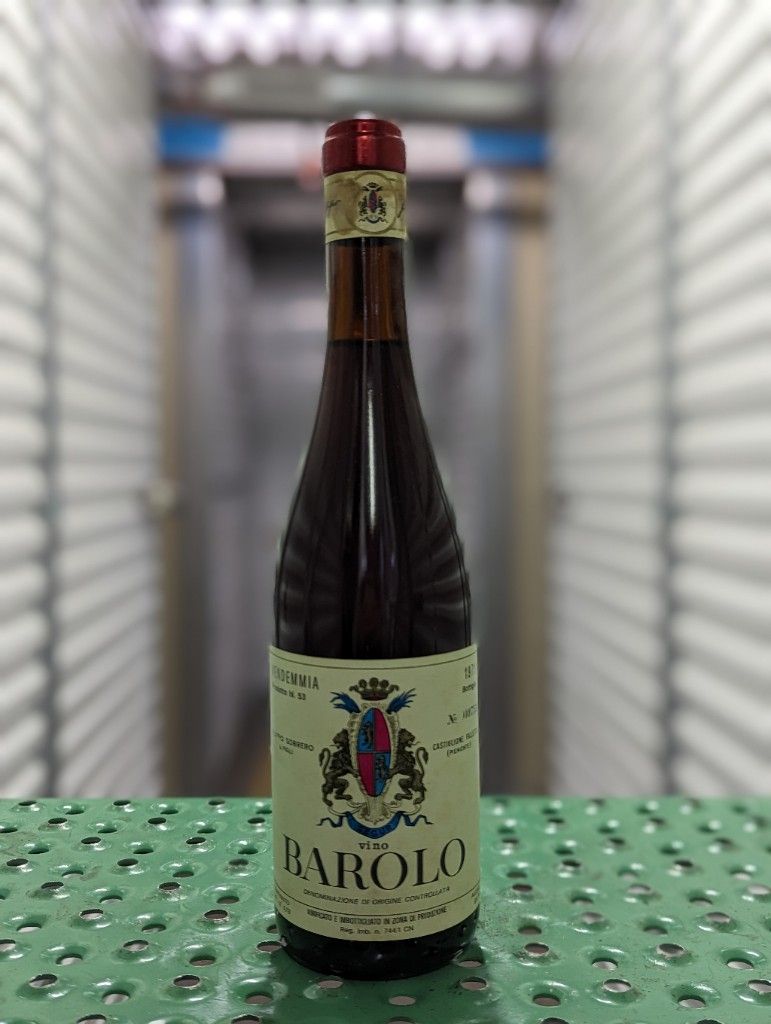
External search
Google (images)
Wine Advocate
Wine Spectator
Burghound
Wine-Searcher
Vintages
1982
1980
1979
1978
1974
1971
1970
1969
1968
1967
1965
1964
1962
1961
From this producer
Show all wines
All tasting notes
|
| Drinking Windows and Values |
| Community Tasting History |
| Community Tasting Notes (average 92 pts. and median of 92 pts. in 3 notes) - hiding notes with no text | | | Tasted by cct on 2/4/2023 & rated 91 points: Dinner at the Goldberg's, NYC
A mature nose. Riper and rounder (in a relative sense) to the '71 with red fruits, rose, soy, decaying leaves, and balsam notes. On the palate, it's a little richer but less focused than the '71 with lovely inner mouth perfume. More autumnal notes and a similar vein of minerality to the '71. Drink up. Less good than my last bottle, but also I did not spend several hours with it the time. 91 (624 views) | | | Tasted by kenv on 2/4/2023 flawed bottle: NK Monprivato Vertical (Chez Goldberg, Greenwich Village, NYC): [Double-decanted about noon.] Weird nose. Not a good bottle. (773 views) | | | Tasted by cct on 12/12/2020 & rated 93 points: Double decanted in the AM for sediment.
A fully tertiary nose with undergrowth, decaying leaves, iron, porcini, medicine cabinet, some soy, dried rose petals, and red fruits. It's supple and mid weighted on the palate. Savory and umami driven with more porcini, iron, pot pourri, and red nebbiolo fruit. The balsam notes have turned to amaro. This has a lot going on, and there is sense of calm and balance that I love. I'm not sure if it is the power of suggestion knowing the fruit source, but this has textural detail like an older Monprivato. It's autumnal, and even for my necro leaning palate for nebbiolo, this is starting to fade. That said, this is fading beautifully. Quite long on the back end. Drink up if you've got them.
This was pretty terrific with umami driven pork and leek dumplings and Xian Bing meat pies. The umami notes of the wine and the dumplings were really synergistic. (861 views) |
| NebbioloNebbiolo is a red grape indigenous to the Piedmont region of Italy in the Northwest. The grape can also be found in other parts of the world, though they are not as respected.
Nebbiolo is often considered the "king of red wines," as it is the grape of the famed wines of Barolo DOCG, Barbaresco DOCG, and Roero DOCG. It is known for high tannins and acidity, but with a distinct finesse. When grown on clay, Nebbiolo can be very powerful, tannic, and require long aging periods to reach its full potential. When grown on sand, the grape exhibits a more approachable body with more elegant fruit and less tannins, but still has high aging potential.
"Nebbiolo" is named for the Italian word, "nebbia", which means "fog", in Italian and rightfully so since there is generally a lot of fog in the foothills of Piedmont during harvest.
Nebbiolo is a late-ripening variety that does best in a continental climate that boasts moderate summers and long autumns. In Piedmont, Nebbiolo is normally harvested in October.
More links:
Varietal character (Appellation America) | Nebbiolo on CellarTrackerItaly Italian Wines (ItalianMade.com, The Italian Trade Commission) | Italian Wine Guide on the WineDoctorPiedmont Vignaioli Piemontesi (Italian only)
On weinlagen-infoLanghe Consorzio di Tutela Barolo Barbaresco Alba Langhe e Roero | Union of Producers of Albese Wines (Albeisa)BaroloRegional History:
The wines of Piedmont are noted as far back as Pliny's Natural History. Due to geographic and political isolation, Piedmont was without a natural port for most of its history, which made exportation treacherous and expensive. This left the Piedmontese with little incentive to expand production. Sixteenth-century records show a mere 14% of the Bassa Langa under vine -- most of that low-lying and farmed polyculturally. In the nineteenth century the Marchesa Falletti, a frenchwoman by birth, brought eonologist Louis Oudart from Champagne to create the first dry wines in Piemonte. Along with work in experimental vineyards at Castello Grinzane conducted by Camilo Cavour -- later Conte di Cavour, leader of the Risorgimento and first Prime Minister of Italy -- this was the birth of modern wine in the Piedmont. At the heart of the region and her reputation are Alba and the Langhe Hills. This series of weathered outcroppings south of the Tanaro River is of maritime origin and composed mainly of limestone, sand and clay, known as terra bianca. In these soils -located mainly around the towns of Barolo and Barbaresco -- the ancient allobrogica, now Nebbiolo, achieves its renowned fineness and power.
map of Barolo DOCG
An interesting thread on Traditional vs. Modern Barolo producers:
https://www.wineberserkers.com/forum/viewtopic.php?f=1&t=106291 |
|




